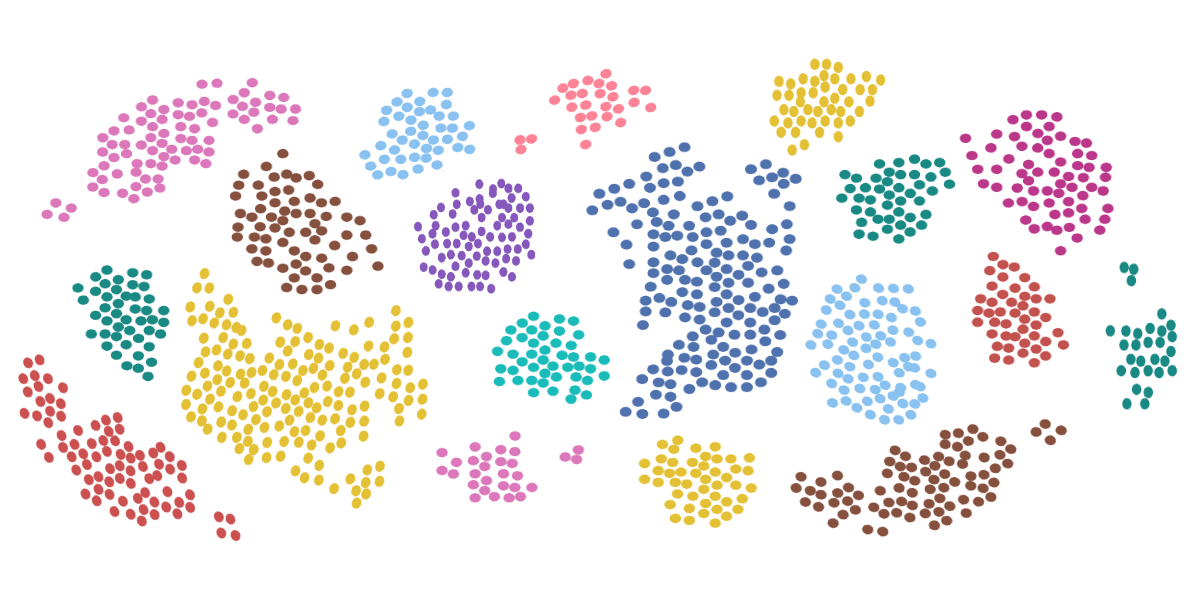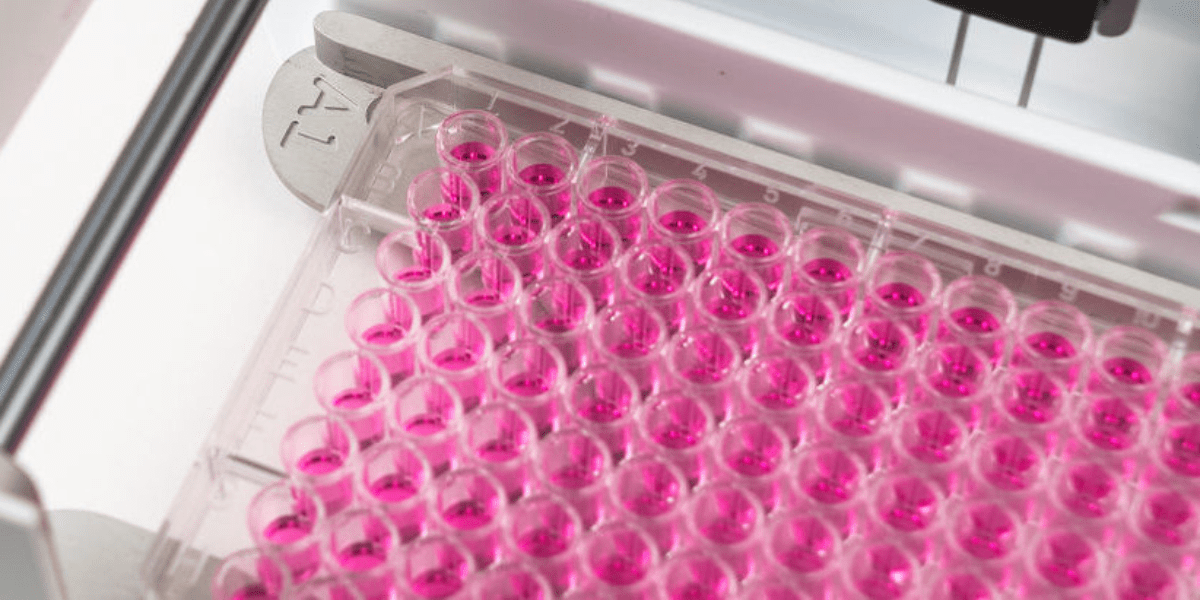The Advantages of Cell Sorting by Flow Cytometry

When working with heterogeneous cell populations (i.e., any immunological, stem cell, or cytogenetic fluid), it’s crucial to be able to look at cells in isolation. Otherwise, when testing different stimuli, the number of variables that come with heterogeneity will prove to be overly complex.
Thus, cells need to be analyzed, characterized, and then sorted. Yet, cells are microscopic. There are literally millions of cells in every drop of blood…
Enter, flow cytometers.
So how does flow cytometry work? Flow cytometry is a technique that can record and analyze multiple parameters simultaneously, sort the individual cells based on their characteristics, and keep the sample healthy and alive. Are you beginning to see the advantages of cell sorting by flow cytometry? We’re just getting started.
Heterogeneous Fluids | Advantage #1
To understand flow cytometry’s utility, it’s important to look at its real-world application. To begin, let’s look at a sample of human blood:
- 60% of the sample will be plasma
- 40% of the sample will be white blood cells, platelets, and red blood cells.
Breaking down white blood cells (which constitute a minuscule portion of the 40%) even further:
- 55–73% of WBC will be neutrophils
- 20–40% of WBC will be lymphocytes
- 2-8% of WBC will be monocytes
- 1–4% of WBC will be eosinophils
- 0.5–1% of WBC will be basophils
And this is just a healthy average. Often, a flow cytometry machine is used in cancer testing and research. Which means that some of these WBC will be altered by cancerous cells within the blood.
When looking at a sample of blood, you may just see a red liquid. At the microscopic level, however, there are various cells, all with different nucleic structures, volumes, and functions. Analyzing stimuli response without isolation means that the reasons are so multivariate, it’d be nearly impossible to make cause-and-effect assertions.
The cell populations have to be sorted.
Fluorescence-Activated Cell Sorting
FACS is a type of flow cytometry sorting. The idea is that blood (or whatever heterogeneous fluid you’re working with) will have multiple cell populations. Each cell population has certain protein structures that can be targeted with specific antibodies. You can fluorescently label these antibodies and release them into your sample. The antibodies attach to the cells in question and then are sent through the flow cytometer.
When the fluorescently labeled cells flow through the laser light, they react with a photon emission, signaling to the system to electrically charge (positive or negative) the cell.
From there, magnets pull apart the cells into different cell collectors.
Analyzing Single Cells | Advantage #2
It’s important to remember when speaking on cell sorting, we’re on the microscopic scale. Literally, prokaryotic cells and eukaryotic cells are between 0.1 µm to 100 µm. Which means the process of cell sorting requires some form of automation. Otherwise, how would it ever be possible to analyze the individual cells, separate them manually, and produce a homogenous sample large enough to perform a test on?
Short answer: it wouldn’t.
Thus, again, why flow cytometry has become so revolutionary in all areas of cell biology.
Process of Flow Cytometry Cell Sorting
To grasp the automated process of flow cytometry, you need to understand the three underlying principles:
- Fluid dynamics
- Optics
- Electronics
Fluid Dynamics
There is a liquid that streams around the sample injection point of the flow cytometer known as sheath fluid. The machine circulates this buffered saline solution until it reaches laminar flow.
- Fluid Dynamics Principle 1 – Laminar Flow – Liquids can move in turbulence (which is generally the case) or in laminar flow. Turbulence is when the particles within the liquid are moving unpredictably and chaotically. Laminar flow is reached when the layers of the liquid are all moving cohesively together in a predictable manner.
Laminar flow is important for two reasons.
- When you inject your heterogeneous solution, you don’t want it mixing with the sheath fluid. At laminar flow, because the layers of liquid slide past each other, there is very little to no mixing that occurs.
- At laminar flow, the layers of liquid at the outermost edges have zero velocity, while the liquid at the center runs at a maximum velocity.
This second reason is key for isolating the cells and ensuring the laser hits every single cell one at a time. It’s a principle known as hydrodynamic focusing.
- Fluid Dynamics Principle 2 – Hydrodynamic Focusing – Because the center of the heterogeneous solution moves at a higher speed than the sides, when it’s injected into the sheath fluid, it creates a natural funneling effect. This focusing effect creates a single-file line of cells flowing past the laser.
Additionally, the sheath fluid surrounding the cell doesn’t cause disruptions in the data. Because it’s moving in laminar flow, the laser refraction is minimal and can be ignored.
Optics and Electronics
Now that the cells are moving toward the laser one at a time, they can be analyzed and properly sorted. This is the key with flow cytometry cell sorting, separating and isolating the cells from the solution first, then physically sorting them into the individual cell collectors second.
Here’s where optics and electronics play a role.
In the case of fluorescence-activated cell sorting, the laser excites the fluorochrome antibody attached to the cell, the fluorochrome then releases photons, the photon is funneled through filters, mirrors, and eventually photomultiplying tubes for detection. The detector sends a signal to an electric charging ring. This ring places a positive or negative charge onto the droplets passing through.
- How does this operate so fast? Remember, we’re talking about the speed of light here. That’s 299,792,459 meters per second!
Another reason why cell sorting in flow cytometry is so effective, the cells can be separated into three different groups simultaneously (positive, negative, and neutral).
Related: Taking a Closer Look at Excitation and Emission Spectra in Flow Cytometry
Thousands of Cells Per Second | Advantage #3
Modern flow cytometers operate at highly efficient speeds, analyzing thousands of cells per second. While this is incredibly fast, it should also be contrasted with how small cell volumes are.
- In one pinhead-sized drop of blood (1 ml), there’s roughly 5 million red blood cells.
Doing some quick math here… carry the 1… that’s about 83 seconds to sort 1 ml of blood. Thousands of cells per second sounds a little more impressive, but still, you get the picture. This is yet another advantage of flow cytometry: you can observe an entire cell population at once.
Keeping Cells Alive | Advantage #4
Sorting cells would yield fruitless results if the population died while being sorted. In fact, this was a problem with early cell sorters and is still a contentious issue with flow cytometers. The point of sorting cells is to then utilize the homogenous fluids. This could be to test medications or treatments, introduce various stimuli, or to observe the cell cycle across its four different stages.
Regardless of the purpose of cell sorting, one aspect that runs true across all of them is the requirement of healthy, happy cells.
Related: How to Complete Cell Cycle Analysis via Flow Cytometry
Choosing the Proper Equipment | WOLF Cell Sorter
To combat this pain point, NanoCellect created a flow cytometer that would ensure the healthy continuation of cell populations after being sorted. This is done by significantly lowering the internal pressure to levels that are thirty times safer than standard models of cell sorters. Further, it handles cells about ten times gentler than the leading flow cytometers. This is just one of the many reasons why labs are utilizing the WOLF Cell Sorter. Additionally, NanoCellect’s machine is:
- Compact and flexible in any laboratory environment. Coming in at under 2 cubic feet, the WOLF Cell Sorter is the perfect countertop flow cytometer and cell sorter.
- Simple to understand and easy to use. The WOLF Cell Sorter was created for both the professionals working in the field and the beginners just starting out. Intuitive software and fixed optics do the heavy lifting, while zero fluidics carts make for a simple clean up.
- Free of contaminants and biohazards. Because the microfluidic cartridges are disposable, there’s practically zero chance that you’ll have to worry about cross contamination. Additionally, the cell sorter is aerosol-free, which creates a more sterile and safe working environment.
With an internal pressure of less than 2 psi, the WOLF Cell Sorter is the perfect machine to take advantage of all the advantages of flow cytometry cell sorting and antibody development.
Multiparameter Analysis | Advantage #5
Often times, cell populations within your sample can’t be isolated based on one metric alone. With flow cytometry cell sorting, multiple detectors are being utilized to analyze different cell characteristics.
- Forward Scatter (FSC) – Forward light scatter refers to the refracted light past the cell into a detector behind the laser. The amount of refraction refers to the size and volume of the cell.
- Side Scatter (SSC) – The scattered light refracted at a 90-degree angle typically informs of the granularity of the cell—the complexity of the nucleic structure.
By combining these two data sets, cells can be analyzed while they’re being separated.
Flow Cytometry Cell Sorting
As you can see, the advantages of flow cytometry are vast. If you’re working with heterogeneous fluids, there is no more useful tool than a flow cytometer. The ability to label cells, isolate them, and continue further testing afterward creates incredible opportunities for cell biologists and medical researchers. Instead of operating on multiple cells at once and guessing to their nature, you can test each cell population individually to determine stimuli response.
If you work in biological or medical fields, you need a machine that doubles down on the advantages of flow cytometry cell sorting and antibody development. Talk to the experts at NanoCellect today to see how the WOLF Cell Sorter can create efficiencies in your lab.
Sources:
- NCBI. Blood Groups and Red Cell Antigens. https://www.ncbi.nlm.nih.gov/books/NBK2263/
- Healthline. WBC (White Blood Cell) Count. https://www.healthline.com/health/wbc-count
- Protocols Online. Phosphate buffered saline. https://www.protocolsonline.com/recipes/phosphate-buffered-saline-pbs/



